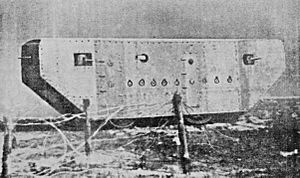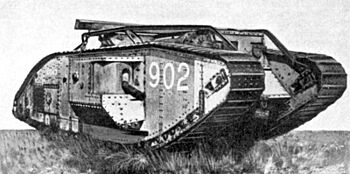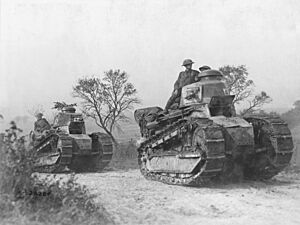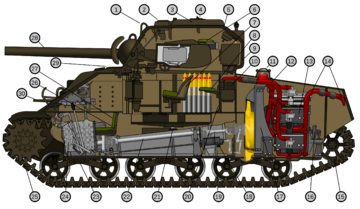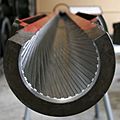Tank facts for kids
A tank is a powerful armored vehicle used in battles. It usually has a large cannon on top that can turn all around, plus a few machine guns.
Tanks are covered in thick armour to keep the crew safe from enemy attacks. They move on special tracks instead of wheels. These tracks help spread out the tank's heavy weight. This lets tanks drive over rough ground, mud, and even trenches. Most tanks have a strong main gun and one or more machine guns.
A tank's crew usually has 3 to 5 people. There is always a driver, a commander, and a gunner. Some tanks also have a loader, who helps load the main gun. This way, the gunner can focus on aiming. In WWII, some tanks also had a separate soldier just for the radio.
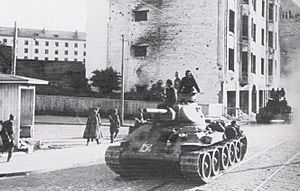
Contents
How Tanks Were Invented
Tanks are a modern version of an old idea: giving soldiers mobile protection and strong weapons. Key inventions like the internal combustion engine (which powers vehicles), thick armour plate, and the continuous track (the moving belt system) led to the tank we know today.
Long ago, in 119 BC, during the Han–Xiongnu War, a Chinese general named Wei Qing used armored wagons. These wagons formed rings to protect his archers and infantry from enemy cavalry charges. This allowed his troops to use their ranged weapons safely.
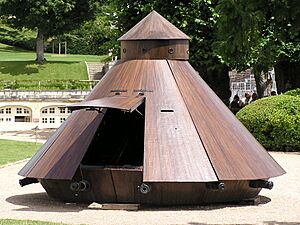
Many people think Leonardo da Vinci or H. G. Wells imagined tanks first. Leonardo drew a wheeled vehicle with cannons in the late 1400s. It was powered by people, but it would have been very hard to move. In the 1400s, Jan Žižka also built armored wagons with cannons. He used them well in battles.
The idea for the "caterpillar track" came from trying to make vehicles move better. These tracks spread out the weight and give more grip. Experiments with tracks started as early as the 1600s. By the late 1800s, practical track systems existed in several countries.
In 1903, a French captain named Léon René Levavasseur suggested putting a field gun in an armored box on tracks. The first armored car was made in Austria in 1904. But these early vehicles could only move on smooth ground or rails. The invention of a practical caterpillar track was what finally allowed tanks to move anywhere.
In 1908, explorer Robert Falcon Scott thought about using tracked vehicles for snow. His engineer, Reginald Skelton, developed a caterpillar track for snow. These vehicles were built and tested. Scott died in 1912, but his team believed his "motors" inspired the British tanks of World War I.
In 1911, an Austrian army engineer, Günther Burstyn, showed plans for a small, three-person tank with a turning gun. That same year, an Australian engineer, Lancelot de Mole, sent a basic design for a tracked, armored vehicle to the British. All these ideas were turned down. By the start of World War I, no one in charge seemed to be thinking much about tanks.
Tanks in World War I
At the end of 1914, some British Army officers tried to convince their leaders to build armored vehicles. They suggested using caterpillar tractors, but the army didn't think they could be armored. Because of this, early tank development in the United Kingdom was done by the Royal Navy.
Winston Churchill, who was in charge of the navy, created the Landship Committee in February 1915. This committee worked on designing a machine that could cross wide trenches. To keep it secret, the designers worked in a locked room. Their first design, called Little Willie, ran in September 1915. It helped them develop the track system.
A better design, called "Mother," was ready in January 1916. This design was chosen for future tanks. The first order for tanks was placed in February 1916. The first tanks were called "Males" (with cannons and machine guns) and "Females" (with only machine guns). They fought in the first tank battle at the Somme in September 1916. Great Britain made about 2,600 tanks during the war.
The first tank to fight was a British Mark I Male, on September 15, 1916. Soldiers reported that "three huge mechanical monsters" scared the enemy. When the news came out, Prime Minister David Lloyd George gave credit to Winston Churchill for pushing the idea.
French Tanks
In France, an artillery colonel named J.B.E. Estienne proposed detailed plans for a tank in late 1915. This led to two types of tanks, the Schneider and Saint-Chamond, but they were not very good.
The next year, France made a big step forward with the Renault FT light tank. This tank was the first to have a gun that could turn all the way around in a turret. It also had its engine at the back. This design, with the gun in a turning turret and the engine at the rear, became the standard for most tanks around the world, even today. The FT was the most common tank of the war, with over 3,000 made.
German Tanks
Germany had very few tanks in World War I. They only started making them after seeing British tanks. The A7V was the only type they made, and only 20 were built during the war. The first tank-versus-tank battle happened on April 24, 1918, when three British Mark IVs fought three German A7Vs. Germany mostly used captured British tanks.
Other Countries
The United States used tanks from France and Great Britain in World War I. American-made tanks were just starting production when the war ended. Italy also made two Fiat 2000 tanks, but they were too late for battle. Russia built and tested two prototypes, the Vezdekhod and the huge Lebedenko, but neither went into production.
Even though tank tactics improved quickly, problems like mechanical failures and poor movement limited how important tanks were in World War I. However, military thinkers knew that tanks would play a big role in future wars.
Between the World Wars
Between World War I and World War II, tanks continued to improve. Military thinkers like Heinz Guderian in Germany developed new ideas for using large groups of tanks to attack quickly. This idea became known as "blitzkrieg."
Germany, Italy, and the Soviet Union tested tank warfare during the Spanish Civil War. This war showed that tanks needed cannons, not just machine guns, and stronger armor.
Another war in 1939, between the Soviet Union and Japan at Khalkhin Gol, taught the Soviets about using tanks with gasoline engines. They used these lessons to build their new T-34 medium tank for World War II.
Before World War II, the way tanks were used changed a lot. German General Heinz Guderian said, "Where tanks are, the front is." This idea became real in World War II. His ideas, combined with Germany's existing tactics of fast movement and surprise attacks, formed the basis of blitzkrieg at the start of World War II.
Tanks in World War II
World War II was the first war where armored vehicles were key to winning battles. Tanks and their tactics developed very quickly. Armored forces could win battles in a very short time. However, new anti-tank weapons also showed that tanks were not unbeatable.
In the invasion of Poland, tanks worked closely with infantry. But in the Battle of France, Germans used "blitzkrieg" tactics. They made deep, fast attacks with tanks, supported by close air support and motorized infantry. This gave them a huge advantage. The French Army had good tanks, but they lacked radios in many tanks. This made it hard for them to respond to German attacks.
The North African Campaign was also important for tanks. The flat, open land was perfect for fast tank battles. But it also showed how important supplies were. Armies often moved faster than their supplies, leading to stalemates. This changed in 1942 at the Second Battle of El Alamein, where the German forces lost most of their tanks due to supply problems.
When Germany invaded the Soviet Union, the Soviets had a great tank design, the T-34. But a lack of preparation, mechanical issues, and poor training led to many Soviet tanks being destroyed. However, the huge size of the conflict and the Soviets' ability to make many tanks prevented Germany from winning quickly.
The Germans had to upgrade their tanks. They built the larger Tiger heavy tank in 1942 and the Panther medium tank in 1943. The T-34 became the most produced tank of World War II, with about 65,000 made.

The United States also used its mass production to build thousands of M4 Sherman medium tanks. The Sherman was reliable, but it was not as strong as the German Panther or Tiger in tank-versus-tank fights. However, the Allies had more tanks and better supplies. This helped them defeat German forces during the Battle of Normandy. Upgraded Shermans with stronger guns were introduced. About 42,000 Shermans were built during the war.
Tank bodies were changed to make flame tanks, mobile rocket artillery, and vehicles for tasks like clearing mines or building bridges. Special self-propelled guns, which could also destroy tanks, were developed by Germans and Soviets. These vehicles were simpler and cheaper than tanks. But as manufacturing improved, the turning gun turret was seen as the best way to mount a main gun, giving tanks more flexibility.
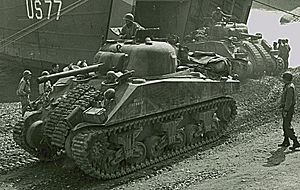
Tanks in the Cold War
During the Cold War, the competition between the Warsaw Pact (led by the Soviet Union) and NATO (led by the United States) pushed tank development forward. Tank designs from the end of World War II became the basis for new tanks. They had large turrets, good suspension, powerful engines, sloped armour (angled armor for better protection), and big guns (90mm or larger).
Cold War tanks added better fire control, gyroscopic gun stabilization (keeping the gun steady), better radios, and more comfort for the crew. They also got laser rangefinders and infrared night vision. Armor technology kept improving to protect against new anti-tank weapons, especially anti-tank guided missiles like the TOW.
The medium tanks of World War II became the "main battle tank" (MBT) of the Cold War. MBTs took over most tank roles. This change happened in the 1950s and 1960s because light tanks were not fast enough, and medium tanks were too weak against new weapons.
Many tanks from after World War II, like the T-55 and T-72, are still used today. Some of the important tanks of the 1950s were the British Centurion, the Soviet T-54/55, and the US M48. These tanks formed the main armored forces for NATO and the Warsaw Pact for much of the Cold War. Later tanks like the Leopard 2, M1 Abrams, and Challenger 2 learned from these earlier designs.
Tanks from the Cold War were used in many smaller wars, called proxy wars. These included the Korean War, Vietnam War, and Arab-Israeli conflicts. Military experts studied these wars to help develop new tanks.
Tanks Today
Today, tank-versus-tank battles are less common. Tanks now often work closely with infantry (foot soldiers) in cities. Tanks can provide covering fire for infantry. Or, tanks can lead attacks while infantry follow in armored carriers.
Tanks were important in the 2003 US invasion of Iraq. The M1 Abrams tanks used by the United States Army proved very useful in city fights. They were upgraded with more armor to protect against roadside bombs.
Israeli Merkava tanks have special features to help them work with infantry in smaller conflicts. They have a rear door and a passage, allowing them to carry infantry and let them get out safely. They also have advanced computer systems and a TROPHY active protection system that protects the tank from anti-tank weapons.
Related pages
Images for kids
-
A cutaway view of a 105mm rifled Royal Ordnance L7 tank gun.
-
The PLA's Type 99a tank with camouflage paint.
-
Soldiers camouflage their T-34 tank with natural materials in 1941.
-
An M1 Abrams tank leaving a Landing Craft Air Cushioned vehicle.
-
A German Army Leopard 2A6M tank with networked battlefield technology.
-
A Merkava Mark 4 main battle tank with a digital battle-management system.
See also
 In Spanish: Carro de combate para niños
In Spanish: Carro de combate para niños


